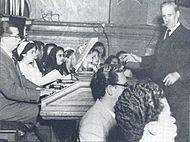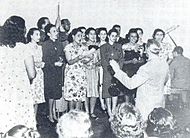Vicente Emilio Sojo facts for kids
Quick facts for kids
Vicente Emilio Sojo
|
|
|---|---|
 |
|
| Background information | |
| Born | December 8, 1887 Guatire, Miranda state, Venezuela |
| Died | August 11, 1974 (aged 86) Caracas, Venezuela |
| Genres | Classical |
| Occupation(s) | Musicologist, educator, conductor and composer |
| Associated acts | Venezuela Symphony Orchestra, Orfeón Lamas |
Vicente Emilio Sojo (born December 8, 1887 – died August 11, 1974) was a famous Venezuelan musician. He was a musicologist (someone who studies music), an educator (teacher), and a composer (someone who writes music). He was born in Guatire, a town in Miranda state, Venezuela.
Contents
A Life Dedicated to Music
Early Life and Musical Journey
Vicente Emilio Sojo came from a family of musicians. Both of his great-grandfathers were "Chapel Masters." This meant they were in charge of music at a church.
In 1896, when he was nine years old, he started learning music. His teacher was Professor Régulo Rico. Later, in 1906, he moved to Caracas, the capital city.
In Caracas, he joined the School of Music and Declamation in 1910. At the same time, he taught himself about Humanities. During this period, he began writing his first musical pieces.
Becoming a Music Professor
By 1921, Vicente Emilio Sojo became a Music Professor at the same school. He continued to compose many different types of music. He wrote for various instruments and singers.
In 1928, a choir called the Orfeón Lamas was started. For this special event, he wrote his first "polyphonic opus." This is a musical work with many independent voice parts singing together.
Founding Orchestras and Choirs
By 1930, Maestro Sojo was the conductor of the Orfeón Lamas. He also founded the Venezuela Symphony Orchestra. He was not just the founder and conductor, but also a strong leader for the orchestra.
In 1940, he worked with other composers to create the first songbook for Venezuelan children. This helped many young people learn about music.
In 1944, the first group of composers graduated from the José Ángel Lamas school of music. These students had been taught by Maestro Sojo himself.
Sojo's Political Role
Maestro Sojo also took part in the country's politics. In 1941, he helped start a political party called Accion Democratica (AD).
Later, in 1958, he was chosen to be a senator for the Miranda state. He was chosen again in 1963. This shows he was important in both music and government.
His Legacy in Venezuelan Music
Vicente Emilio Sojo is seen as one of the most important people in modern Venezuelan music. For the Orfeón Lamas choir, he collected and arranged over 200 folk songs. These were popular songs and traditional music from Venezuela. By doing this, he helped save a lot of Venezuelan musical history.
Some of his most famous works include "Chromatic Mass" (written between 1922 and 1933) and "Hodie Super Nos Fulgebit Lux" (from 1935). In 1951, he received the National Music award. This award recognized all his amazing work.
One of Sojo's students was a talented musician named Alba Quintanilla.
Musical Works by Sojo

- 1911 Himno a Bolívar
- 1912 Romanza sin palabras
- 1913 Cuarteto en Re, for strings
- 1914 Partitura para festiva
- 1914 Tres motetes para la iglesia Santa Capilla
- 1915 Misa Coral
- 1918 Salve Reina
- 1920 Obertura Treno
- 1922 Ave María
- 1923 Misa Cromática
- 1924 Ocho responsorias y un Te Deum
- 1925 Palabras de Cristo en el Calvario
- 1926–1927 27 canciones de ayer
- 1928 Por la Cabra Rubia
- 1929 Requiem Inmemorian Patris Patriae
- 1930–1933 Misa Breve
- 1935 Misa a capella en honor a Santa Efigenia y a su fallecida esposa,La Noche, La Carretera, Rondel Matinal and Hondie nos Fulgebit Lux
- 1939 Tres canciones infantiles
- 1952 Tres piezas para guitarras
- 1953 Misa para Santa Cecilia
- 1958 10 canciones infantiles venezolanas
- 1964–1969 9 Canciones infantiles
See also
 In Spanish: Vicente Emilio Sojo para niños
In Spanish: Vicente Emilio Sojo para niños
- Music of Venezuela


